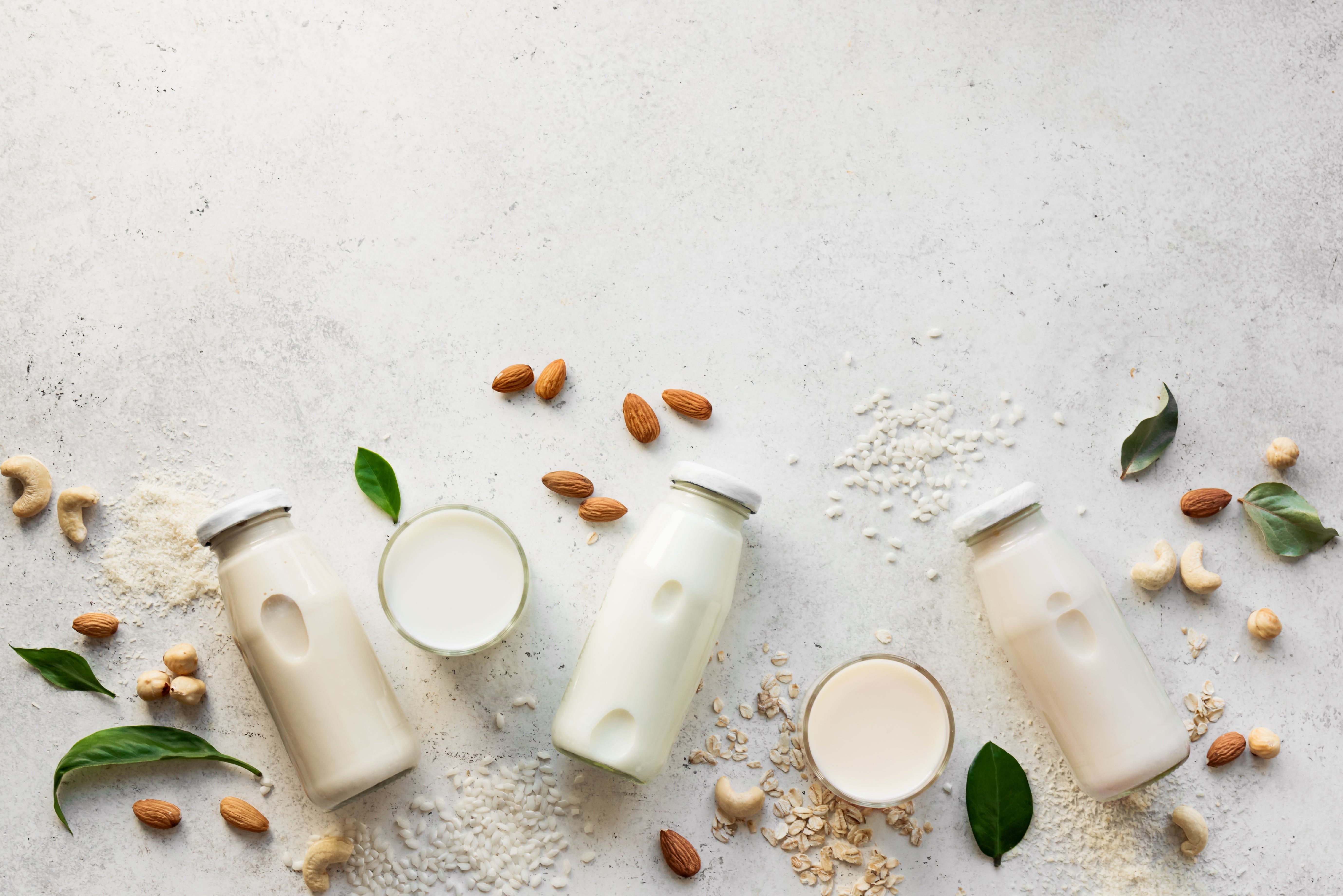So, you’re ditching dairy. Maybe it’s for digestive reasons, maybe you’re experimenting with different diets, or maybe you just want to see what all the hype is about. Whatever the reason, swapping out dairy doesn’t have to mean missing out on key nutrients—but you do need to be strategic about it.
Not all dairy-free alternatives are created equal. Some are loaded with added sugars, some lack protein, and others straight-up taste like disappointment. So, let’s break it all down and figure out which dairy-free options actually deliver on nutrition, taste, and functionality.
What Nutrients Are in Dairy (That You Need to Replace)?
Dairy products—like milk, cheese, and yogurt—are known for three key nutrients: ✅ Calcium – Essential for bone health, muscle function, and nerve signaling. ✅ Protein – Important for muscle growth, satiety, and overall health. ✅ Vitamin D – Helps with calcium absorption and immune function.
If you’re cutting dairy, you need to make sure you’re getting these nutrients elsewhere. The good news? There are plenty of solid dairy-free alternatives that can fill in the gaps.
Dairy-Free Milk Alternatives: Pros and Cons
1️⃣ Almond Milk 🥛🌰
✅ Low in calories (30-50 kcal per cup, unsweetened) ✅ Good source of vitamin E (great for skin & immune health) ✅ Usually fortified with calcium & vitamin D
🚨 Downside: Very low in protein (only 1g per cup), so don’t expect it to fuel your workouts.
Best for: Coffee, smoothies, cereal
2️⃣ Soy Milk 🥛🌱
✅ Protein-packed (7-9g per cup, close to cow’s milk) ✅ Good source of calcium, vitamin D, and B12 (when fortified) ✅ Contains isoflavones (which have potential heart-health benefits)
🚨 Downside: Some people avoid soy due to concerns over phytoestrogens (though research suggests moderate intake is fine).
Best for: Baking, protein shakes, coffee
📌 Research: A study in The Journal of Nutrition (2018) found that soy protein can help maintain muscle mass just as well as whey protein when combined with resistance training.
3️⃣ Oat Milk 🥛🌾
✅ Creamy texture, slightly sweet flavor ✅ Contains fiber (beta-glucans) for heart health ✅ Often fortified with calcium & vitamin D
🚨 Downside: Higher in carbs (15-20g per cup) and lower in protein (2-3g per cup) compared to soy or dairy milk.
Best for: Lattes, oatmeal, baking
📌 Research: A study in The American Journal of Clinical Nutrition (2020) found that beta-glucans from oats can help reduce LDL cholesterol and improve heart health.
4️⃣ Coconut Milk 🥛🥥
✅ Rich, creamy texture (great for curries and coffee) ✅ Contains healthy fats (MCTs), which may support metabolism ✅ Naturally lactose-free
🚨 Downside: Almost no protein (0-1g per cup) and can be higher in saturated fat than other alternatives.
Best for: Curries, smoothies, coffee creamer substitute
📌 Research: MCTs (medium-chain triglycerides) in coconut milk have been shown to increase fat oxidation (Obesity Research & Clinical Practice, 2015).
5️⃣ Cashew Milk 🥛🥜
✅ Super creamy and blends well in recipes ✅ Lower in calories (25-50 kcal per cup, unsweetened) ✅ Often fortified with calcium & vitamin D
🚨 Downside: Low in protein (1g per cup), so not ideal for muscle recovery.
Best for: Coffee, soups, sauces
Dairy-Free Yogurt Alternatives: What’s Worth It?
| Type |
Protein |
Probiotics |
Calcium |
Best For |
| Soy Yogurt |
6-8g per cup |
✅ Yes |
✅ Often fortified |
Smoothies, breakfast bowls |
| Almond Yogurt |
1-3g per cup |
✅ Yes |
✅ Often fortified |
Snacking, toppings |
| Coconut Yogurt |
0-2g per cup |
✅ Yes |
❌ Usually lower |
Desserts, thick texture |
| Oat Yogurt |
2-4g per cup |
✅ Yes |
✅ Often fortified |
Creamy texture, fiber |
Best Option for Protein? Soy Yogurt Best Option for Taste? Almond or Coconut Yogurt
Dairy-Free Cheese Alternatives: The Good, The Bad, The Cheesy
Let’s be honest—vegan cheese is hit or miss. Some taste like heaven, others taste like cardboard. Nutritionally, most dairy-free cheeses aren’t great (lots of processed oils, little to no protein), but some decent options exist.
✅ Nutritional Yeast – Tastes like parmesan and is high in B vitamins. ✅ Cashew-Based Cheese – Higher in healthy fats, great for spreads. ✅ Soy-Based Cheese – More protein than nut-based, but texture varies.
🚨 What to Watch Out For: Many dairy-free cheeses are highly processed with added starches and oils. If you’re going dairy-free for health reasons, check ingredient labels and opt for brands with minimal additives.
The Verdict: What’s the Best Dairy-Free Alternative?
🥇 Best for Protein: Soy milk or soy yogurt 🥇 Best for Creaminess: Oat milk or cashew milk 🥇 Best for Coffee: Almond milk or oat milk 🥇 Best for Cooking: Coconut milk (for savory dishes), soy milk (for baking)
If protein is your priority, soy-based options are your best bet. If you’re just looking for a solid milk substitute with good taste and texture, oat or almond milk are solid choices.
Final Thoughts: Don’t Just Swap, Optimize
Going dairy-free? Cool. Just don’t swap without a plan. Make sure you’re getting enough protein, calcium, and vitamin D from other sources so you don’t end up with nutrient gaps.
And remember—just because something is dairy-free doesn’t mean it’s automatically “healthy”. Many plant-based alternatives are ultra-processed and loaded with sugar, so read your labels and choose wisely.
Now go forth and enjoy your dairy-free lattes, smoothies, and mac & cheese—without sacrificing nutrition.
References
-
Messina, M. (2016). "Soy foods, isoflavones, and the health of postmenopausal women." The American Journal of Clinical Nutrition.
-
Tosh, S. M., & Bordenave, N. (2020). "Health benefits of oat beta-glucan: A review of scientific evidence." The American Journal of Clinical Nutrition.
-
St-Onge, M. P., et al. (2015). "Medium-chain triglycerides increase energy expenditure." Obesity Research & Clinical Practice.
-
Feskanich, D., et al. (2014). "Milk and health: Current evidence and future research directions." The American Journal of Clinical Nutrition.
-
Clarys, P., et al. (2014). "Nutritional profile of plant-based cheeses compared to dairy cheese." Food Chemistry.
Meet Fitnexa, your AI-driven companion that turns everyday habits into a positive, uplifting journey. From effortless meal analysis (including recipe suggestions) to personalized coaching and real-time support, Fitnexa keeps you on track toward lasting wellness — so you can stay younger, live longer.







Leave a comment
This site is protected by hCaptcha and the hCaptcha Privacy Policy and Terms of Service apply.